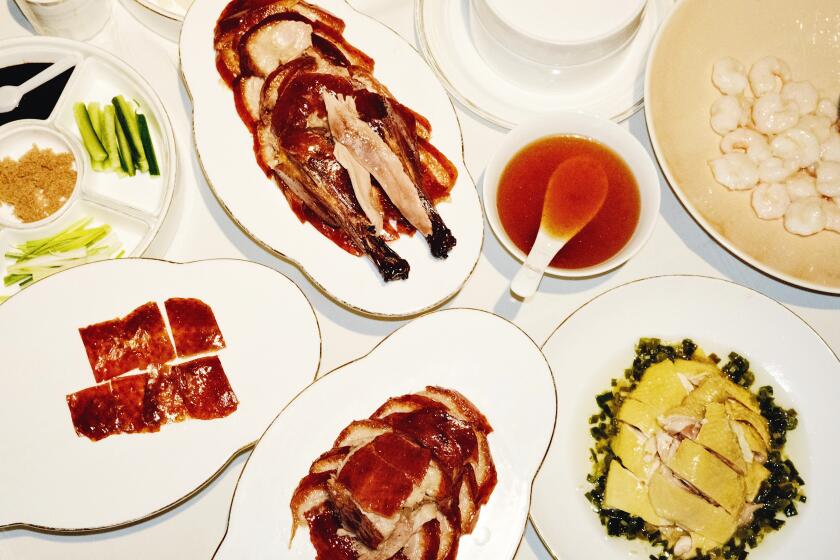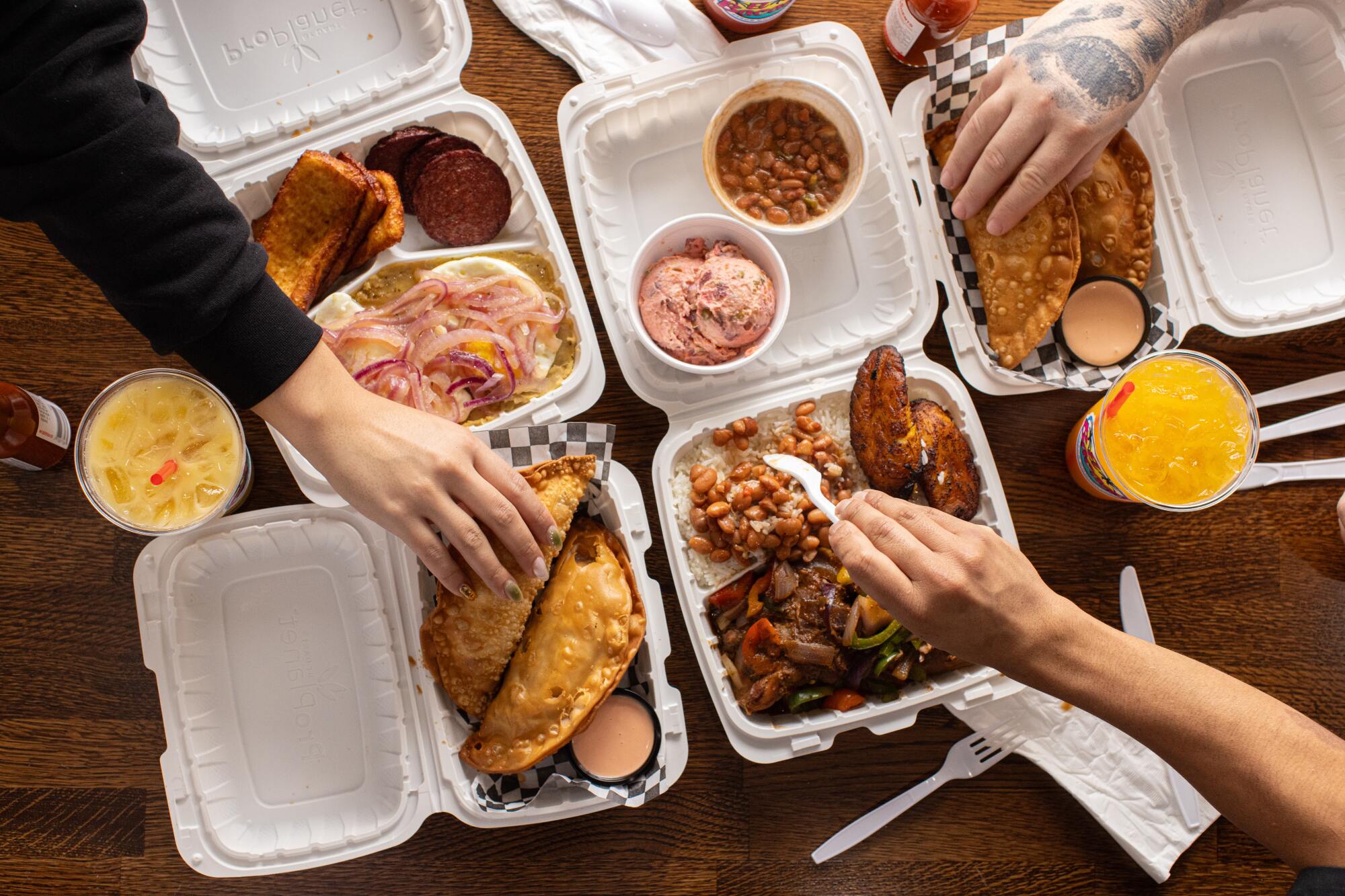
- Share via
Jonathan Santana opened the sole bricks-and-mortar Dominican restaurant in the Los Angeles area last summer. He was a teenager in the 2000s, though, when he first considered that his family’s recipes might be the basis for a business.
Among eight siblings, his mother, Maria (nicknamed “Machi”), was known as the one with the golden hands at the stove. Jonathan’s friends would come over after school, expecting Machi’s flaky empanadas or fragrant stewed chicken. They loved her food so much that when she wasn’t around, they not-quite-joked about their willingness to pay her to cook.
The family lived in Anchorage. They moved there when Jonathan was 5, not long after his maternal grandparents had sponsored the family’s immigration to New York from the Dominican Republic. Other aunts and cousins had already relocated to Anchorage for job opportunities and the relatively low cost of living.
Southern chef Sammy Monsour returns to downtown at Joyce, where he channels his imagination toward seafood and other coastal-inspired dishes.
In 2010, the Santanas made the entrepreneurial leap to launch Nina’s in a Box, named both for Machi’s mother and the squat trailer out of which they operated. Machi and Jonathan’s older sister Deany led the kitchen; Jonathan and other relatives helped wherever they were needed. Their menu included chicken, soaked in soy-based marinade and then stewed or fried, with rice and plantains, and pork chops with similar flavors, and occasionally a highly spiced burger topped with shredded cabbage for light crunch.
Nina’s ran for four years in Anchorage. Jonathan cites the harsh Alaskan winters, toiling in a thin-walled structure, as one big reason why everyone eventually wanted to move on.
Nearly a decade later, history started repeating itself. Jonathan was spending time with friends in Los Angeles. He’d cook the family recipes, and people would mention these were dishes they’d shell out money for.
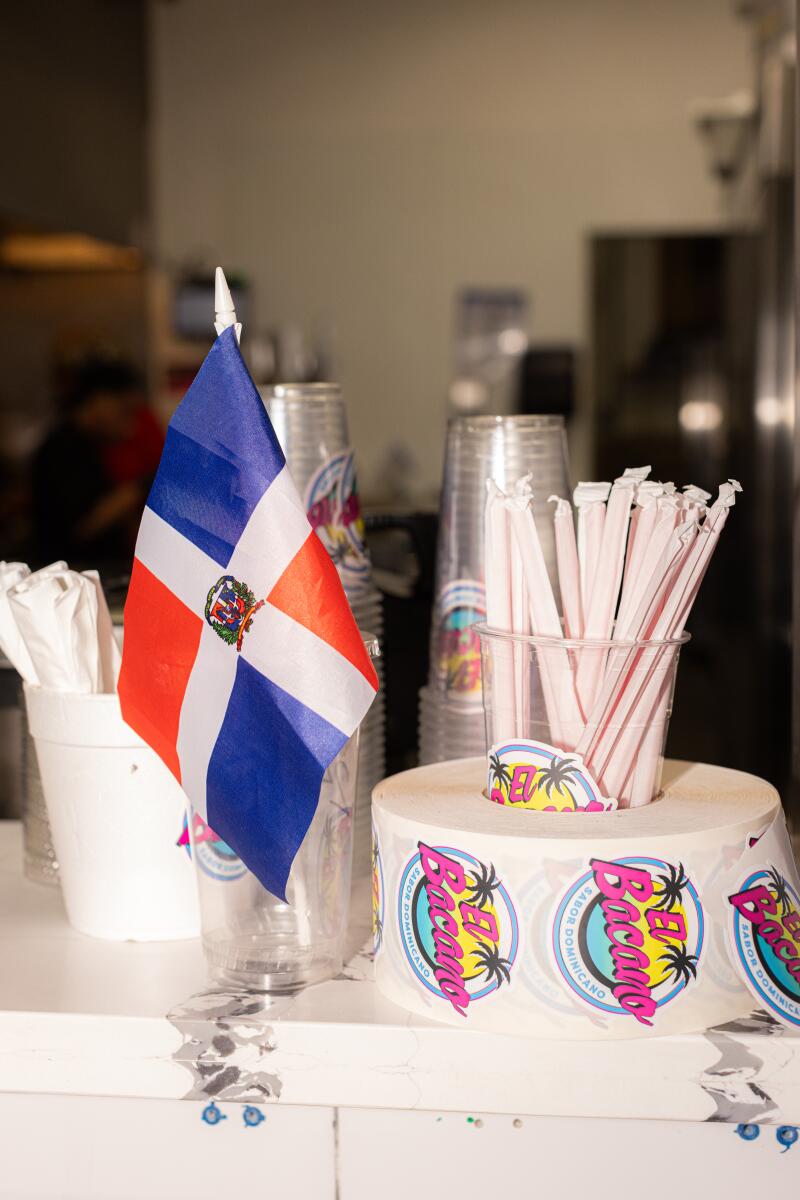
The Santanas relocated from the Dominican Republic to Anchorage, where they ran a restaurant called Nina’s in a Box, before moving to Los Angeles.
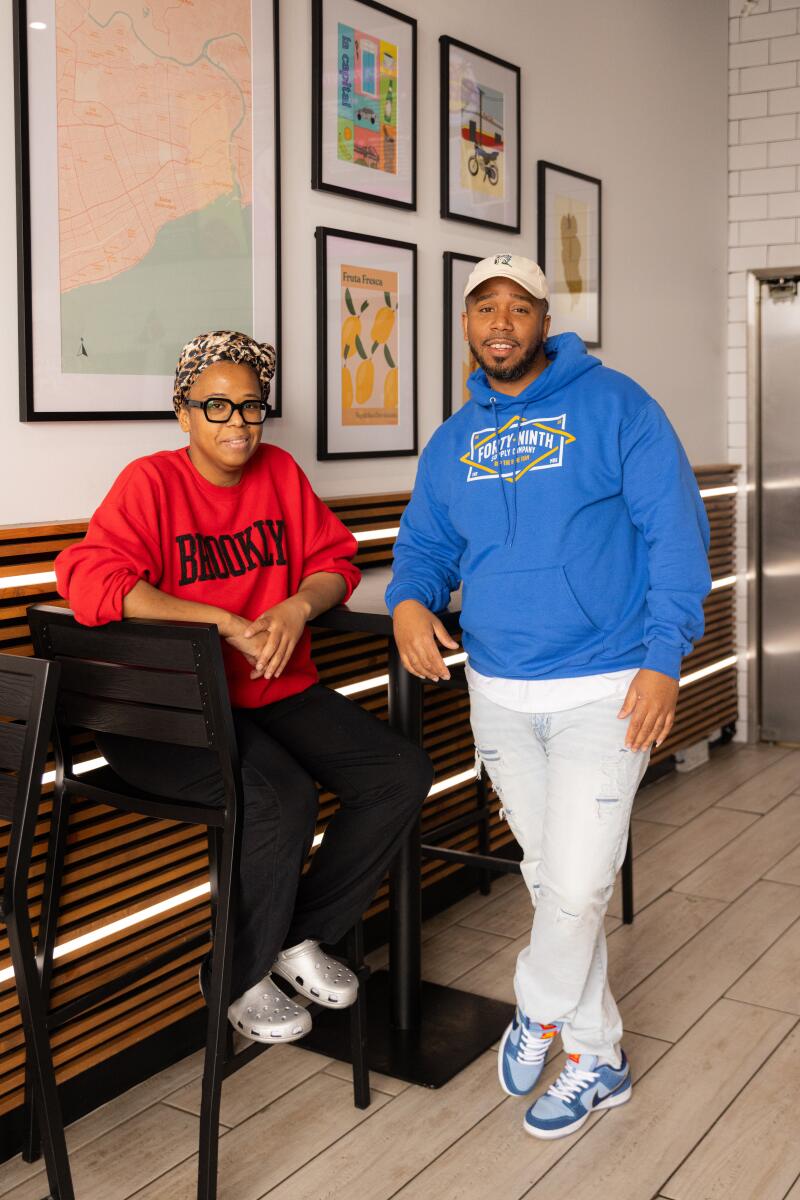
Deany and Jonathan Santana decided to open El Bacano to share their family’s recipes.
He also wondered: Where were the Dominican restaurants in L.A.? Weekly pop-ups such as El Coro Café in Glendale and the Dominicans, based out of downtown, represent the cuisine, and a food truck specializing in Dominican cooking called Karibbean Cuisine parks in Mid-City. Jonathan envisioned a bricks-and-mortar location with a few tables, mostly focused on takeout and one that felt well insulated from the weather, even if the climates of Southern California and the Alaska Peninsula couldn’t be more different.
Jonathan recruited Deany as chef for the project. In August, the siblings began the next chapter of the family’s restaurant lineage with 16-seat El Bacano in a North Hollywood strip mall.
They unlock their doors at noon but serve a quintessential Dominican breakfast that comforts righteously at any time of day: mangú (mashed plantains) with los tres golpes, or “the three hits”: two fried eggs, slices of griddled salami and thin rectangles of queso frito. A staffer will ask if you prefer the plantains green or ripe, and my answer is the one the Santanas recommend: a mixture of the two.
Their combined consistency is at once smooth and gently textured, and the taste leans slightly toward sweetness, though slivers of pickled onion strewn over the top bend the overall flavors back toward savory. Yolks run, if you ask for the eggs over easy, the speckled salami has snap, and the cheese squeaks a little between the teeth.
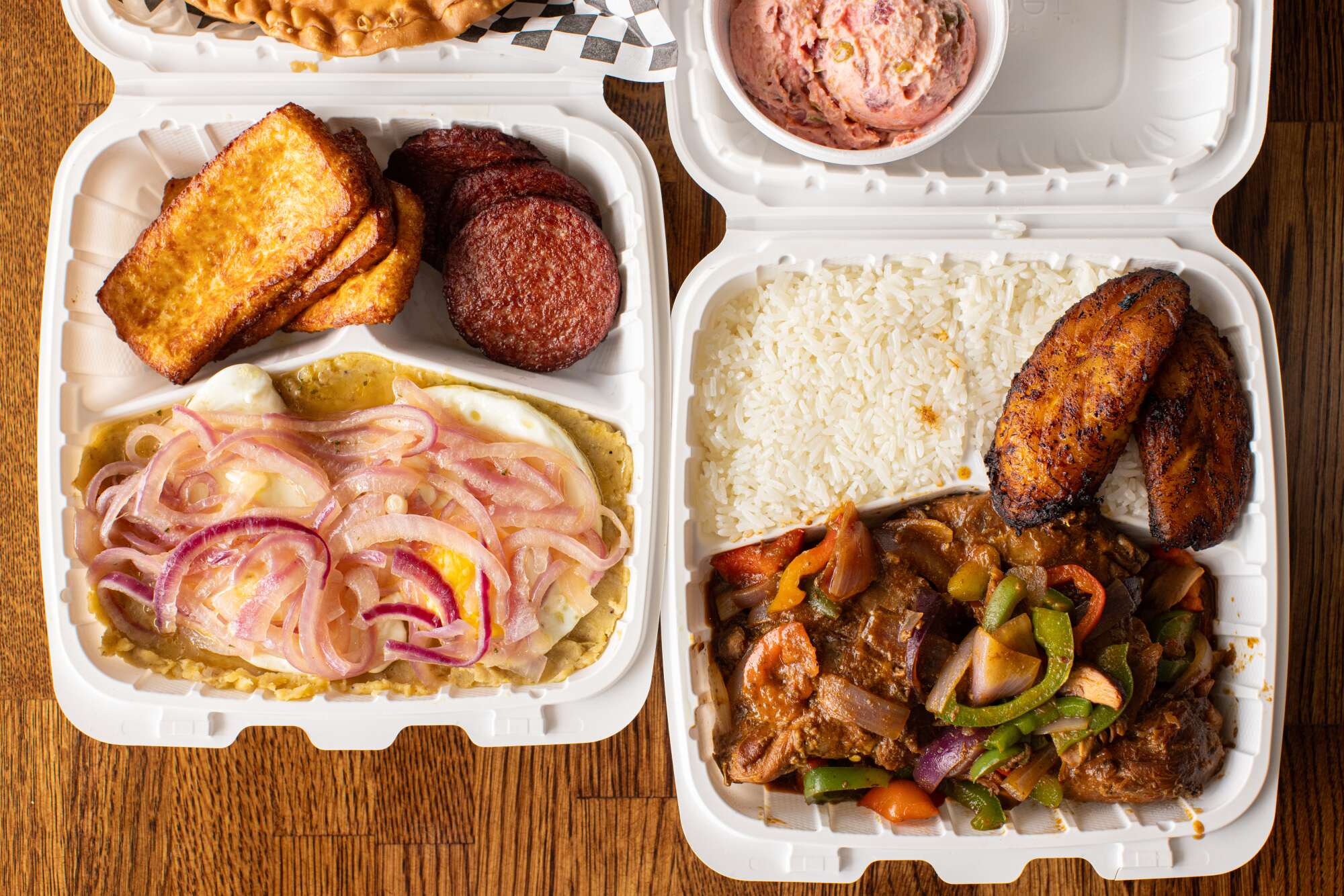

It’s also possible at El Bacano to order mangú paired with other meats from the menu in ways that recall how Puerto Ricans often serve their keystone dish, mofongo — green plantains usually fried and pounded into a garlicky mash. Mangú con los tres golpes is a national signature for Dominicans, though; start here as an entry point.
Besides, the meats deserve their own limelight, and a less scene-stealing backdrop of rice frames them perfectly.
Most stem from the marinade on which Nina’s menu was also built: an infusion of lime juice, onions, garlic, oregano and other spices. I’m especially partial to Santana’s chicken, Jonathan’s renaming of the classic Dominican pollo guisado. The bird is richly browned — the siblings are giving away none of their family’s secrets, but a common technique involves adding sugar to the oil to achieve such depth of color — and then simmered with thinly sliced peppers in a bit of liquid that forms a brothy, potent gravy.

The bright, floral wallpaper of El Bacano.

Morir sonando, a mixture of citrus juice and milk, is a signature drink.

Santana’s chicken is Jonathan’s renaming of the classic Dominican pollo guisado. The simmering liquid forms a brothy, potent gravy.

Dishes come with soupy beans and white rice. You can upgrade to moros — an abbreviation of “moros y cristianos,” rice and beans cooked together.
Chicken legs typically comprise the dish. The thoroughly braised meat all but pulls away from the bone on its own.
Like most entrees, the plate comes with a small salad, soupy beans and white rice. For a $2 surcharge, one can upgrade to moros — an abbreviation of “moros y cristianos,” rice and beans cooked together, that references 700 years of conflict between Moors and Christians in Spain that began in the eighth century. The culinary term is common across Caribbean-Latin cultures, and a direct reflection of Spanish colonization. Deany makes several variations, using black or red beans or pigeon peas and sometimes tinged with tomato paste, that revolve through the week. I appreciate their subtle layers of seasoning.
A chef pours a Beijing-style spirit over the roast duck, then aims a butane torch gun … and whoosh. You’re here for the flaming duck at Array 36 in Temple City.
I’d also readily point you to La Bandera, marinated beef braised to the lushness of pot roast. Its name refers to a ubiquitous Dominican lunch plate of beans, rice and meat that (with some creative license) recalls the red, white and blue colors of the national flag.
Avocado disrupts the patriotic palette, but it’s a staple part of Dominican meals, and El Bacano’s staff will ask you at least once if you’d like a side order. Its silken charms blend in everywhere: against the crackle of sheer fried chicken; slipped under the bun of the cabbage-topped burger, gloppy with mayonnaise and ketchup; or mashed into the rice that catches the tomatoey juices of sauteed bacalao.
A few welcome slices also lighten the heft of sancocho, another Dominican signature. Cuts of pork, beef and chicken meld in a stew with plantains, rounds of corn on the cob, winter squash and yautia, a root vegetable sometimes called malanga. The spices are restrained, the flavors straightforward. During recent rainy weeks in Los Angeles, sancocho has warmed me mightily, especially with generous, brightening shots of hot sauce. The restaurant sets out three brands on its tables.
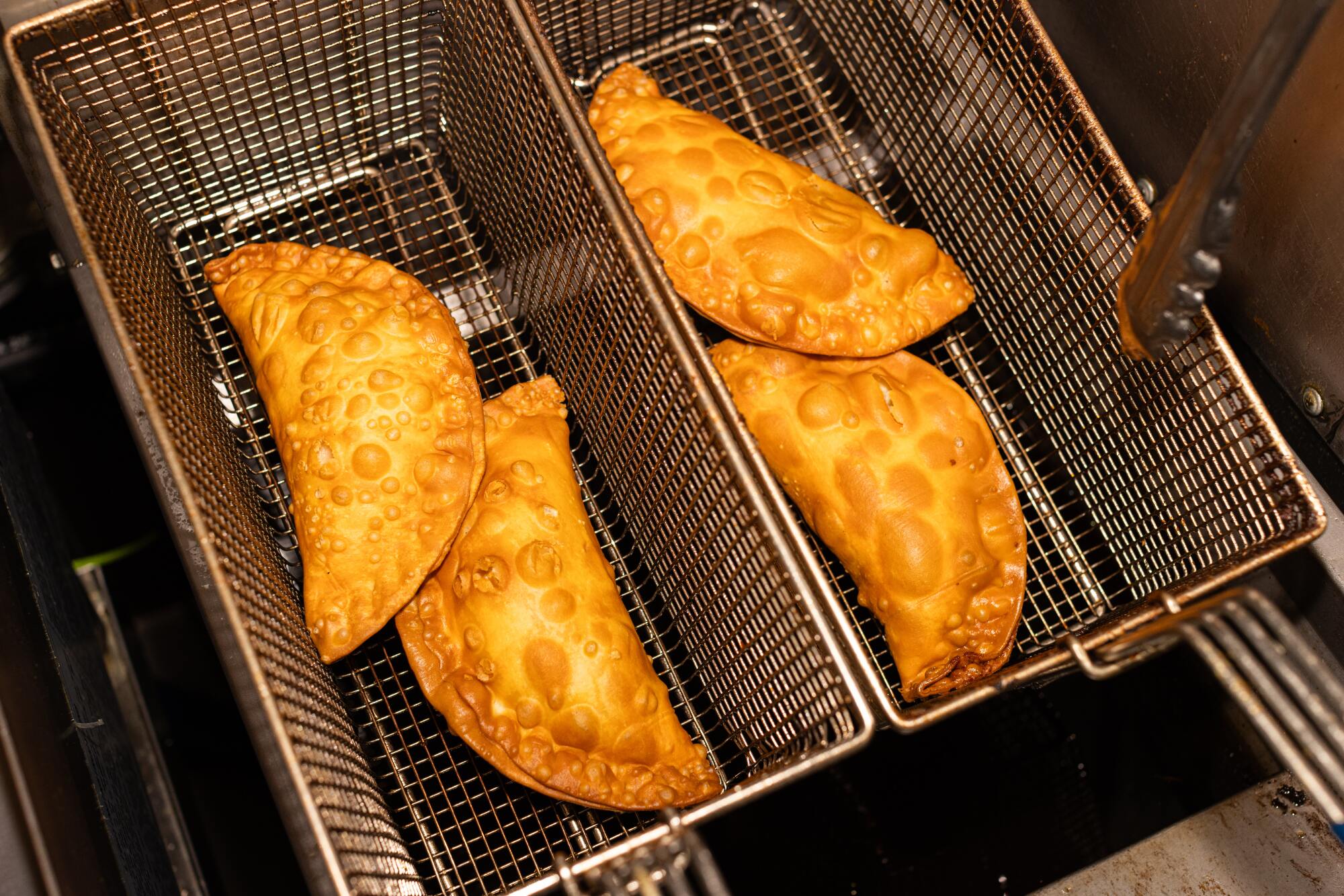
My one major complaint: Whether you’re carrying out or eating in the dining room, El Bacano serves everything in to-go containers. Sancocho should be spooned out of a proper bowl, and the pollo guisado’s meaty juices need to bleed into the rice rather than stay trapped in a Styrofoam compartment. The food travels well, so I’ve taken to bringing meals home and plating dishes to best savor them.
Jonathan speaks of expecting a diverse clientele in the restaurant’s first year but being happily surprised that Dominicans drive from all over the region, grateful and nostalgic for the smells and tastes. “Things are going well, so I’m hoping to open a second location with double the space and a bar where we can serve Dominican spirits,” he says.
When the next one happens, he assures me he’ll invest in tableware befitting his mother’s recipes.
El Bacano
13009 Victory Blvd., North Hollywood, (818) 210-0026, elbacano.com
Prices: Most entrees $16-$20, empanadas $3-$5, sandwiches $12-$15.
Details: Open noon-9 p.m. Tuesday-Sunday. No alcohol (though try the sour-sweet tamarindo juice). Lot parking.
Recommended dishes: Mangú con los tres golpes, Santana’s chicken (pollo guisado), La Bandera, empanadas with shredded chicken or salami and cheese, sancocho (available on Tuesday, Thursday and Saturday), bacalao guisado.
More to Read
Eat your way across L.A.
Get our weekly Tasting Notes newsletter for reviews, news and more.
You may occasionally receive promotional content from the Los Angeles Times.

